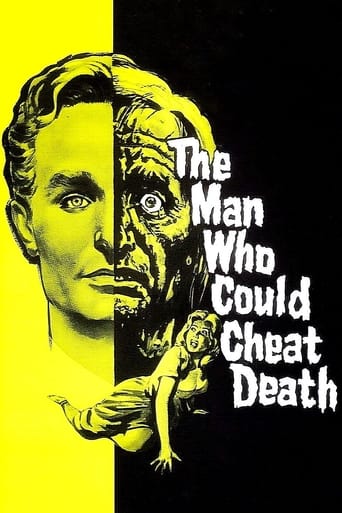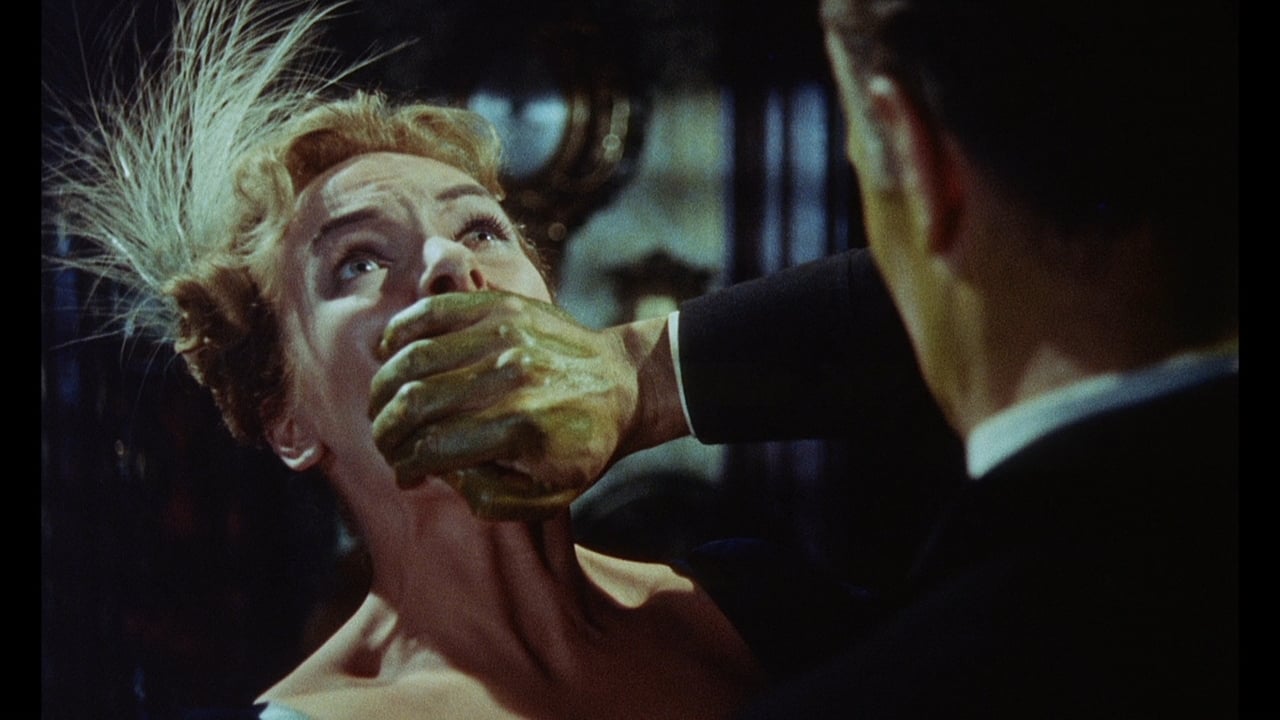MARIO GAUCI
This is among the first Hammer Horrors I watched but, after checking it out twice on Italian TV as a kid (once as part of a late-night horror programme called "Zio Tibia Horror Picture Show" featuring a couple of amiably grotesque puppets, which is how I first caught up with the likes of BRIDE OF FRANKENSTEIN {1935} and THE GHOST OF FRANKENSTEIN {1942}!), the film seems to have dropped off the radar completely in my neck of the woods; finally, it was recently released on R1 DVD by Legend Films since this was the only title from the legendary British company to be distributed by Paramount. It is actually the third version of Barre' Lyndon's play "The Man In Half Moon Street", first filmed in Hollywood in 1943 (albeit only released a couple of years later!) and again for British TV in which Anton Diffring, the star here, actually originated his role (for whatever reason, the name of the protagonist changes from one version to the other!); even so, Hammer's then top leading man Peter Cushing was supposed to play the part but, thankfully, saner minds prevailed as I am not sure he would have been ideal as a ladies' man (the heroine, then, is future "Queen Of Horror" Hazel Court in her last of 2 films for Hammer). It is interesting to have Hammer still adapting stuff from TV at this point, even after they hit the jackpot with reinventing the classic Gothic literary tales! Anyway, having just watched the earlier movie, it is quite clear which is the superior version since Jimmy Sangster's excellent script deals far more thoroughly with the themes inherent in Lyndon's source
which, as mentioned in my review of the original, draws quite a bit from Oscar Wilde's "The Picture Of Dorian Gray" – though, this being Hammer, the horror aspect (aided by Fisher's typically full-blooded handling and Diffring's intense characterization) is a lot more pronounced. That said, Diffring is ably supported by Christopher Lee (who, despite having attained star status thanks to Hammer, generously accepted a supporting and heroic role this time around: oddly enough, his doctor character here shares his name with another one he would play in the later, similarly Sangster-scripted Hammer chiller TASTE OF FEAR {1961}!) and Arnold Marle' (who also reprised his role from the TV version as Diffring's elderly associate).Being a relatively early genre effort by the company, the color palette is very handsome, effectively rendering both the late 19th century Parisian setting and the moments of pure horror, notably the greenish hue emitted by the boiling flask which holds Diffring's life-sustaining serum. Incidentally, while the protagonist of the 1945 version was really a 90-year old, here he is made to be 104 (and it is amusing to watch Diffring try to convince Lee that he is actually a good 15 years older than the stroke-stricken Marle'); again, the protagonist has a dual career as an artist (though he is a sculptor now rather than a painter) but, inconveniently, his models all fall for him and have to be disposed of (which is one of the clues the Police – represented by Francis De Wolff – eventually follow). Here, too, the gland operation is good for a whole decade but, in this case, we are better able to accept the fact that in the interim he tries to rebuild his life, not to mention that when the effect begins to dissipate and Marle' has still not turned up to perform the life-saving operation, he is forced to kill and kill again because the gland withers after a few days!Among the number of differences between the two movie versions one finds that, in the 1945 movie, when the protagonist's colleague is unable to operate, he has to rely on a young man he saves from suicide and who just happens to be a medical student (after having gone through a list of disgraced members of the profession), whereas here it is Lee who gets asked (who is in love with Court herself, naturally) but initially refuses (so that Diffring has to refer to an alcoholic doctor and, bafflingly, an oculist!). Here, too, he does operate eventually but he does not perform the gland transplant, which obviously proves Diffring's undoing; the latter comeuppance is quite messy (much more horrific, in fact, than the original's) – involving both the age reversal (featuring great make-up effects by Roy Ashton) and his being set on fire by a model he had kept imprisoned (and deformed, since apparently his skin becomes abrasive as the effects of the drug fade!) after she discovered his secret.Diffring would follow this with an even more notorious genre outing, CIRCUS OF HORRORS (1960), but he never quite became a star (being too often relegated to playing Nazi officials in Hollywood WWII epics); even so, later horror titles of his include MARK OF THE DEVIL PART 2 (1973; which I will be getting to presently), THE BEAST MUST DIE (1974; for Hammer rival Amicus and with Peter Cushing!) and Jess Franco's FACELESS (1987; which also sees him involved in unethical operations spiced with a series of murders). Incidentally, following these viewings, I am also in the process of acquiring Ruggero Deodato's belated giallo PHANTOM OF DEATH (1988) starring Michael York, Edwige Fenech and Donald Pleasance in view of its apparent thematic similarity to the Barre' Lyndon play.
MartinHafer
This is a film from Hammer Films that was directed by Terrence Fisher--a man who made many of the more famous horror films for this studio. Oddly, although Christopher Lee appears in the film, he's in a supporting role and Anton Diffring, a man NOT used to starring roles, plays the leading man.The film begins with a bizarre art show. That's because the artist is a doctor and he never sells his statues. Additionally, he shows them off once and never lets anyone see them again! None of this made any sense, but the idea that followed is pretty interesting. It seems that although Diffring looked to be in his early to mid 40s, he was supposed to be 104 years old! It seems that he'd discovered a way to make himself live forever--but there was a price. Every ten years, he needed to kill in order to obtain a needed gland that would keep him alive.While all this is pretty exciting stuff, the execution left an awful lot to be desired. You'd think with such a creepy plot it would naturally be exciting, but sadly it wasn't. Part of it may have been that the role didn't fit Diffring's talents very well and part of it may just be the very pedestrian script. All I know is that I found myself being rather bored towards the end and it's not one of Hammer's finer moments.Note that the DVD release contains no extra features at all--just an adequate print of the film. Also, near the very end you find the one lady you think is dead is still alive but quite mad. You wonder why Diffring killed a prostitute for the gland but left this poor wretch locked in a dungeon--this didn't make much sense.
rtomko
Although not one of Hammer's best films, it is a good movie. The Victorian setting (although it is supposed to take place in Paris) is very charming. Some people have criticized the use of heavy fog in Paris but I feel it adds to the eerie and mysterious atmosphere. Christopher Lee is very effective and is a hero - which is rare in early Hammer films. Hazel Court is absolutely beautiful as the heroine. The plot is interesting and moves quite well. Compared to some other old movies that have been released on DVD, this one is a winner. It is truly a film that belongs in a Hammer fan's collection. Too bad Peter Cushing was not in the film because it would have been even better. I hope some Hammer fans read this and make a plea to have the movie released on DVD. At least it could be one movie of a double feature.
english-rose
The Man Who Could Cheat Death is a remake of The Man In Half Moon Street, the stage version of which also starred Anton Diffring. The book of this title gives much more back-ground to the character of Georges Bonnet which explains his actions, but unfortunately is lost in the film version, but I think Anton Diffring conveys the torturous life of Bonnet very well. Although he appears cold and heartless he is in fact in desperate need of being loved in a secure relationship, but because of his past he cannot allow himself to achieve this. He is incapable of understanding why his actions are so wrong, and this makes him a vulnerable character despite his obvious intelligence, success and wealth and in the end invokes pity from the audience. I believe Peter Cushing was originally down to play the starring role in this film opposite his familiar adversary Christopher Lee, but because of other commitments he had to turn down the part and suggested Diffring instead. From appearing cold and heartless to pleading and frightened I think Anton Diffring excels in this film and was the perfect choice for the role, although in some parts the acting would have benefited from more positive directing. Christopher Lee and Hazel Court are excellent in their roles and give fine performances in what is a thought provoking and beautifully shot film.



 AD
AD



